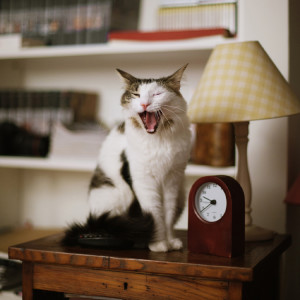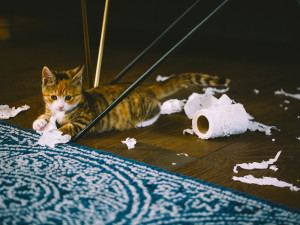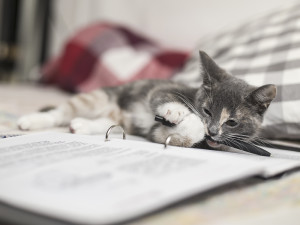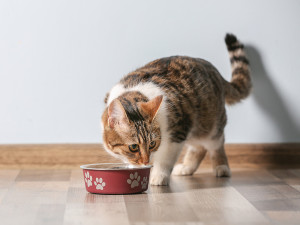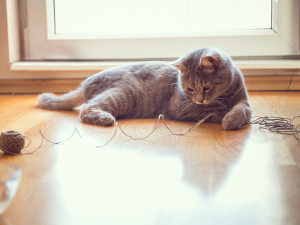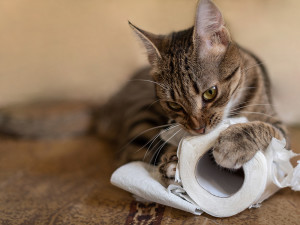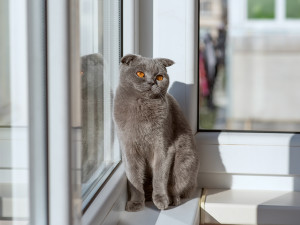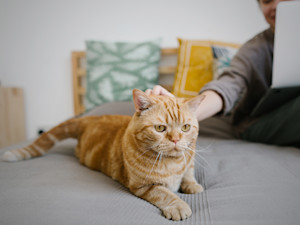Why Does My Cat Throw Up After Eating?
That doesn’t seem normal...

Share Article
In This Article:
Common Causes of Cat Vomiting After Eating Other Serious Health Concerns Vomiting vs. Regurgitation in Cats When to Seek Veterinary Help How To Stop My Cat From Throwing Up After Eating Frequently Asked Questions
If your cat frequently throws up after eating, it can be a concerning and messy issue. While one-off episodes of vomiting may not cause alarm, regular post-meal vomiting may indicate underlying health issues such as hairballs, food allergies, or gastrointestinal disorders.
You’ve spent time researching a great food for your cat, placed it in a carefully selected stainless-steel or ceramic bowl, and served it up in your cat’s favorite spot. Your thanks for all this effort may sometimes be a pile of barf deposited on your favorite rug. Don’t take your cat’s vomiting as a critique of your preparation or a lack of appreciation for your hard work. If your cat is regularly throwing up after eating, there may be a health problem causing their stomach upset.
Common causes of cat vomiting after eating
Eating too fast or overeating
Some cats are obsessed with food and can’t fill their bellies fast enough. Eating too much or eating too quickly causes rapid distension of the stomach, which can trigger regurgitation or vomiting. This can sometimes be a problem if your cat is extra hungry because their feeding schedule was disrupted and too much time has passed between meals.

Hairballs
Even though hairballs have been accepted as a part of cat parenthood, they’re not actually all that normal for cats to vomit up. Cats (even long-haired cats) should be able to pass hair through their stomach and intestines. Vomiting hairballs can be an indicator of gastrointestinal issues in cats.
Food allergies or intolerances
Food allergies occur due to an inappropriate inflammatory response to specific substances in food. Animal proteins are the most common cause of food allergies in cats, but carbohydrate allergies are possible as well. Food allergies most commonly show up as skin issues, but they can can have vomiting, diarrhea, or decreased appetite as symptoms as well.
Food intolerance is a non-allergic response to food due to toxins, GI motility issues, or other causes. If you’re wondering, “Why does my cat throw up after eating grass?” food intolerance is the likely answer. Eating things like grass can cause physical irritation within the stomach and trigger vomiting to rid the body of the irritant.
Parasites
Kittens are more likely to show symptoms of vomiting from intestinal parasites than adult cats, but cats of any age can have worms that lead to digestive problems. Parasites should be considered as a potential cause of vomiting in any cat who goes outside or is not on monthly preventatives.
Other serious health concerns
Vomiting can sometimes indicate that a cat has a more serious issue going on. In addition to vomiting, symptoms like decreased appetite, lethargy, weight loss, and behavior changes can be reasons for concern. Some more concerning causes of vomiting in cats include:
Inflammatory bowel disease
Inflammatory bowel disease (IBD) is a complex disease without an easily pinpointed cause. In a cat with IBD, the intestines become inflamed due to immune system dysfunction. This inflammation leads to worsening of the intestines’ ability to digest food, absorb nutrients, maintain fluid balance, and eliminate waste. These chronic changes can lead to vomiting and other systemic issues.
GI obstruction
Cats with a GI obstruction will often vomit soon after eating because food can’t make its way through their stomach or intestines. Intestinal blockages are more common in young cats and kittens, but cats of any age can fall victim to curiosity and eat something they shouldn’t. Linear foreign objects like strings are particularly tempting and dangerous for cats.
Kidney disease
Cats can lose kidney function gradually as they age or suddenly if they’re exposed to certain toxins like lilies or human NSAID pain medications. The buildup of the byproducts that the kidneys normally excrete can make cats nauseous and cause vomiting.
Thyroid issues
An overactive thyroid gland (hyperthyroidism) is often accompanied by vomiting. Cats with hyperthyroidism are often ravenous but lose weight despite a voracious appetite. Vomiting can be caused by overeating associated with this or as a direct result of the elevated thyroid hormones.
Cancer and gastrointestinal tumors
Vomiting after meals can be caused by cancer as well. Some gastrointestinal cancers are infiltrative and spread throughout the length of the GI tract, affecting its function. Others can cause distinct masses that partially or completely obstruct the passage of food through the stomach or intestines.
Vomiting vs. regurgitation in cats
The first step in finding out why your cat may be vomiting after eating is discovering if they’re actually vomiting. While it may seem unimportant when you’re looking at a pile of partially-digested food on your laundry, figuring out if your cat is vomiting or regurgitating is half the battle.
Vomiting is an active process. Vomiting cats make all kinds of interesting (disgusting) sounds and dramatic motions before and during vomiting. Vomiting is often preceded by nausea, which can cause drooling, hiding, and a pitiful yowl. While vomiting, cats will have abdominal contractions and heaving as they bring up food or liquid from their stomach. This can be accompanied by a distinctive gagging sound that will bring experienced cat parents running from across the house.
Regurgitation is a more passive process — food goes in, then comes back out without much effort on the cat’s part. There may be a slight cough or hack as the food exits, but regurgitation doesn’t involve the dramatics that vomiting does. Regurgitation after eating often results in a fairly solid tube of undigested food rather than the more liquid-y splat of vomit. If you’re not sure if your cat is vomiting or regurgitating, try to record an episode to show your veterinarian. Vets love looking at videos of cats puking.
When to seek veterinary help
It’s not normal for cats to vomit after eating. Even if your cat seems unbothered by it, vomiting is a sign of a problem that needs to be checked out. A single episode of vomiting in an otherwise happy, healthy cat can generally be managed with monitoring at home. See your vet if your cat vomits multiple times in a day, is vomiting regularly, or shows any of these symptoms:
Decreased appetite
Diarrhea
Pain
Lethargy or weakness
Rapid or labored breathing
Straining to urinate or frequent trips to the litter box
Pale gums
How to stop my cat from throwing up after eating
Once you’ve ruled out significant medical problems with your vet, you can employ some at-home methods to get your cat to stop vomiting after eating.
Feeding bland cat food
Your vet may recommend a short course of bland food to help settle your vomiting cat’s stomach. Bland diets are formulated to be easily digestible and allow you to gradually reintroduce your cat to their regular diet once they feel better.
Changing feeding strategies
If your cat can’t get their food into their belly fast enough, changing their eating habits may help. Feeding smaller, more frequent meals can help prevent the rapid stomach distension that triggers vomiting. You can also try slowing their ability to eat food by feeding with a puzzle toy, in a slow-feeder bowl, or by placing balls or rocks (larger than they could possibly eat) in their bowl.
Avoiding sudden diet changes
Cats don’t adjust to abrupt changes in their diet as well as most people do. Avoid switching brands of food, protein types, and food formulations quickly. If you need to change your cat’s diet, do so over a period of a week, by gradually giving a little more of the new food and a little less of the old food each day.
Checking up with your veterinarian regularly
Keep your vet informed of your progress in eliminating your cat’s vomiting after eating. Continue to take your cat to the vet regularly for routine care, examination, and diagnostics.
Giving monthly preventatives
Keep your cat up to date on monthly preventatives as recommended by your vet. This helps protect them from parasites that can cause vomiting and other illnesses. Make sure that all animals in the house are on preventatives to maintain good environmental and household control.
FAQs (People also ask):
Why does my cat throw up after eating dry food?
Cats can vomit after eating dry food for many reasons. If your cat is used to canned food, the sudden change to kibble may upset their stomach.
Why does my cat throw up after eating treats?
Cat treats may not contain the same protein and carbohydrate sources as your cat’s regular food, so the sudden change may cause stomach upset. Avoid giving your cat human foods that can be toxic to them.
Why does my cat throw up after eating wet food?
Giving your cat canned food may seem like a special treat for them, but it can cause stomach upset if they’re not used to that type of food. Always introduce new foods gradually, starting with very small amounts and watching for problems.
References:

Dr. Bartley Harrison, DVM
Dr. Bartley Harrison is a veterinarian with more than 19 years of experience. He has treated a variety of species in emergency and speciality practices for both large and small animals. His primary interests as a vet are emergency medicine and critical care.
Related articles
![Cat grooming itself.]()
Dental Disease in Cats: Signs to Watch Out For and Prevention Tips
Much to their disappointment, taking care of your cat’s teeth is essential.
![Beautiful playful tabby cat lying on the living room floor, playing with a ball of string.]()
How to Treat Intestinal Blockages in Cats
If you see a string sticking out from, uh, behind, never, ever, ever pull on it.
![Cute tabby cat playing with roll of toilet paper.]()
How to to Spot, Treat, and Prevent Pica in Your Cat
There may be a reason your cat can’t stop putting your hair ties in their mouth.
![Uncomfortable looking gray cat sitting on a window sill]()
Should Your Cat Go to the ER?
Here are six good reasons to haul tail to the emergency room.
Why Does My Cat Eat Grass?
And should they?
![Owner pets senior ginger cat.]()
6 Common Health Concerns in Senior Cats
How to spot and how to treat them.


